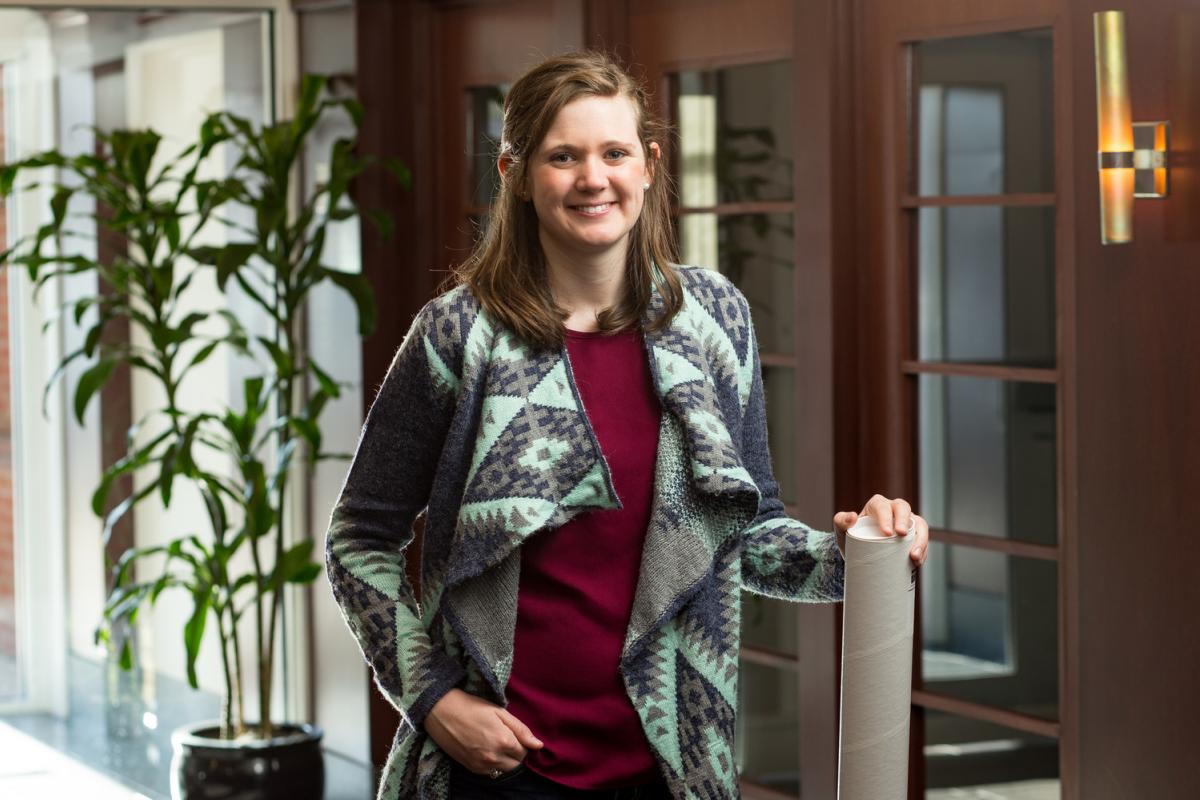"Look, There Goes the Scientist!"
For 25-year-old Kelly Barford, a fourth-year neuroscience graduate student at UVA, just keeping her schedule straight is a challenge. Each week she juggles time in her research lab, science classes she teaches in area elementary schools, and leadership roles in "Women in Math and Science" and "Science Delivered Charlottesville." Recently, Barford took an hour in a coffee shop (coffee is pretty much a staple of her diet) to answer a few questions about the BIMS program—an interdisciplinary graduate program that prepares PhD students to become scientific leaders—and her personal path.
Q: Your research on the sympathetic nervous system is quite complex. Can you summarize?
A: The sympathetic nervous system, what most people associate with the “flight or fight” response, carries impulses, messages, and nutrients back-and-forth from just outside the spinal cord to all parts of the body. That means we’re talking a good distance in the body from, say, the spinal cord to the tips of the fingers. On the cellular level, a lot can go on in that journey. I study the cell biology involved in this process. It’s natural to want to associate biomedical research with its impact on a particular disease—and this work definitely has those implications—but, at its most fundamental level, we are building our base of knowledge of how this system works. That way, we can better understand what’s wrong when it’s not working as it should.
Q: So the BIMS program supports actual, publishable research?
A: Definitely. One of the things I like best about this program is that most of your classes take place in the first year, while you complete rotations in a variety of labs. By the end of that first year, you choose the lab you want to be in and get rolling on your research. You also create a committee of professors in your field to help guide you and evaluate your work. At the end of your second year, you earn your master’s degree. After that, it’s somewhat fluid—depending on how your research progresses. You don’t receive permission to graduate until you are the first author on a peer-reviewed journal and your committee is satisfied with your research progress.
Q: What about funding?
A: Last summer, I received a two-year NIH grant to support my research. Before that, I was fortunate to receive a number of UVA grants, including the Wagner Fellowship and a Double-Hoo Grant. (Note: All of these awards are competitive, based on the strength of the research. The Robert R. Wagner Fellowship was created by Bob and Mary Wagner. Bob Wagner was the first chair of UVA’s Department of Microbiology. The Double-Hoo grant, given to pairs of undergraduate and graduate students working jointly on a project, is administered by UVA’s Center for Undergraduate Excellence. Starting in June 2017, BIMS students will receive their doctoral degrees from the School of Medicine (instead of the College of Arts and Sciences).
Q: You’re also involved in the Women in Math and Science (WIMS) organization. What does that organization do?
A: We promote women in science on multiple levels. For the younger kids, we do lots of outreach, including teaching at elementary schools about four times a year with science activities that are fun and engaging. We know that many elementary teachers feel unprepared to teach science, so we provide a resource for them and help them feel more confident. Most people don’t personally know a scientist. We show the kids that real scientists still exist. We’re out here, and we’re having fun—and making careers—doing research. We also offer support for female graduate students through our Women in Science Stories. These help connect graduate students with professors and local scientists to learn about their journeys through science and networking. In some of the sciences, women are still underrepresented, and there are definitely fewer female professors and principal investigators.
Q: You are also a co-founder of Science Delivered, Charlottesville?
A: Yes, we are actively developing our program, going out to area elementary schools to teach science lab. We wear our lab coats. We’re like the local Bill Nyes. When the kids see me coming down the hall, they say “Look, there’s the scientist!” It’s a lot of fun. We do classes on chemistry, physics (sound waves), and neuroscience now but we’re trying to expand our selection of labs. We get great feedback from the teachers too.
Q: So, what’s a typical week for you?
A: If I’m not teaching, I’m in the lab about 50-60 hours a week, doing the usual things, like growing cells, pipetting, running experiments, writing up results. I also mentor an undergrad assistant. If it’s a teaching week with Science Delivered, then I’m only in the lab about 30-40 hours a week. I also go to seminars and take part in graduate student group activities. I manage our Facebook page, which means keeping up with all of the literature from neuroscience students. To relax, I like to run. Otherwise, I do the things a 25-year-old does, you know, Netflix, hang out with friends, the usual things.
Q: And, what’s next?
A: Well, the next step is usually to look for an industry or university teaching job and establish your own lab. I am still interested in bench science, but I’ve also gotten very interested in science literacy and communicating science, so who knows? Depending on how Science Delivered Charlottesville continues, I could stay working here, or I could try to work for another nonprofit focused on science education and literacy. I’m really passionate about bringing science to the average person, so I’m just seeing where this takes me.
Want to hear more about Barford's research? Watch the video below:

